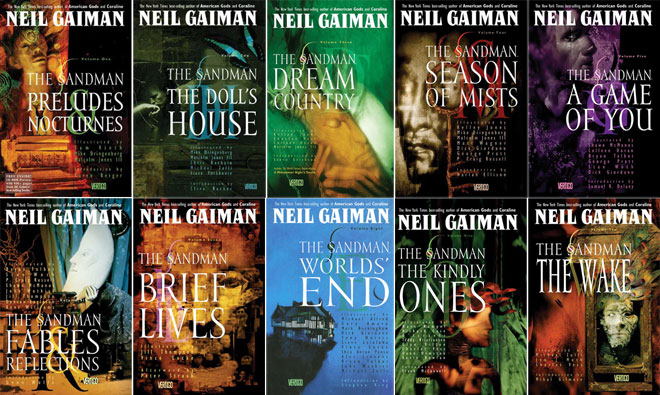Want to hear more from the actors and creators of your favorite shows and films? Subscribe to The Cinema Spot on YouTube for all of our upcoming interviews!
Do you want to start a comics series without having to know the ins and outs of the DC Universe? Are you not really into superheroes but curious as to what graphic novels offer? Do you like mythology? What about dark fantasy? If you answer “yes” to any of these questions, then look no further than Neil Gaiman’s The Sandman.
The Sandman series was originally a monthly serialized publication that ran from 1989 to 1996, and it was then collected into a ten-volume graphic novel series (shown above). Many spin-offs and a prequel to the series have since been written, including Gaiman’s newest addition to the story with The Sandman: Overture, but the beauty of it is that the story entails a clear beginning, middle, and end. This is not an ongoing series to which you have to catch up, and we at Geek Motivation highly recommend it for summer reading.
The series follows the titular character Morpheus–also known as Dream, the Dream-Lord, Oneiros, and many other names–who is the Lord of Dreams. He is responsible for all of humanity’s dreams, and he does not favor creed, religion, philosophy, or any other metaphysical system. In fact, the logic of the story is that all of these systems come from him. Morpheus and his family make up a pantheon of entities, greater than gods, called The Endless, and they represent what are constructed as essential human experiences: Dream, Death, Desire, Despair, Delirium, Destruction, and Destiny.
Morpheus’ journey begins in the volume Preludes & Nocturnes. A character named Roderick Burgess intends to use a spell to capture Dream’s sister, Death, and instead captures the Lord of Dreams. From there, Dream must find a means of escape, and he waits 72 years for the opportunity. However, in his absence, the Dream-Lord could not attend to his duties to humanity, and the world’s dreamers have suffered as a consequence. Rogue dream-entities have escaped Morpheus’s realm of The Dreaming, and they must be dealt with.
Throughout the original ten volumes, Morpheus interacts with gods and goddesses, angels (including Lucifer Morningstar, the character on which the comics title and TV series Lucifer are based), creatures from the realm of the Fae, John Constantine, William Shakespeare, Christopher Marlowe, and many other mortal and immortal entities. This series was a flagship comics title of what the comics community discusses as the Modern Comics Era. Gaiman shares many features of storytelling with his one-time mentor Alan Moore, but he makes The Sandman a world of his own making.
Many, many TV and movie adaptations of the series have been discussed–the most recent being Joseph Gordon-Levitt’s attachment and departure from a movie adaptation in 2016 due to “creative differences”–though not one has been settled. However, with the recent adaptation of his novel American Gods on Starz, Gaiman himself is enthusiastic that someone will finally agree on a premiere television adaptation: “I’m hoping that the success of American Gods will show Time Warner that maybe something as huge and shapeless and strange as Sandman would be best suited to television, with the likes of the dangerous maniacs [Bryan Fuller and Michael Green] sitting next to me making it.”
It is already in the works, folks, so if mythology, dark fantasy, and a comic book series considered to be one of the greatest of all time piques your interest, we at Geek Motivation encourage–no, implore–you to add this gem to your summer reading list.
If you want to see more articles by Geek Motivation, follow us on Twitter: https://twitter.com/GEEKMOTIVATION




8 Comments on “GM Recommended Reading: Neil Gaiman’s The Sandman”